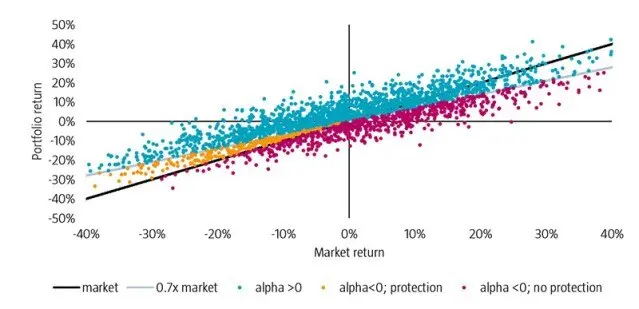Popular low volatility indices have significantly lagged their parent indices since the autumn of 2019. The recent woes for the factor can be explained by the fact that the market has been in ‘risk-on’ mode, i.e. riskier assets have fared better than safer ones.
“
In addition to being short exuberance, low volatility strategies are also short junk
Low Volatility is short exuberance and junk
Low volatility stocks tend to be mature firms with stable earnings and high dividends, which relates to the academic investment, profitability and value factors. Given these style characteristics, low volatility strategies generally tend to struggle during rallies of expensive risky stocks, with rapidly growing balance sheets and weak profitability.
While it is important for investors to be cognizant of this vulnerability of low volatility strategies, they should not interpret it as a fatal flaw, because the growth rallies in question are not supported by improving firm fundamentals. Instead, they are fueled by massive multiple expansion, which eventually tends to mean revert. Thus, low volatility strategies are short exuberance, and although this can cause significant underperformance in the short run, this positioning ultimately pays off in our view.
Low volatility strategies also tend to suffer when distressed stocks rebound. These so-called ‘junk rallies’ tend to be shorter-lived phenomena than the growth rallies discussed above, but share many similarities from a factor perspective. The stocks in question tend to involve high uncertainty, low dividends, a need for fresh capital and low profitability.
Therefore, in addition to being short exuberance, low volatility strategies are also short junk. These features help explain the major drawdowns of low volatility strategies, but also highlight the main risk that investors need to accept in order to harvest the low volatility premium in the long run.
Discover the value of quant
Subscribe for cutting-edge quant strategies and insights.
Alpha volatility can momentarily cause aberrations
Many investors count on low volatility strategies to provide them with capital preservation during severe market downturns. But during the Covid-19-induced market crash in the first quarter of 2020, the downside protection they offered mostly fell short of expectations.1
Low volatility portfolios are characterized by a beta well below 1 and a positive expected alpha which reflects their long-term added value. However, the alpha does not come in a smooth, steady return stream, but involves a considerable amount of uncertainty. Using data from real-life low volatility strategies, we can estimate that the alpha is associated with a volatility of about 6% on an annualized basis.2
The effects of alpha volatility are illustrated in Figure 1 using a Monte Carlo simulation. The black diagonal line reflects the benchmark return and the grey line represents the expected return of a portfolio with a beta of 0.7 and no alpha. The dots depict 2,500 simulated portfolio returns assuming an expected alpha of 2% and taking into account the effects of 6% alpha volatility. The blue dots denote positive alphas, the orange dots negative alphas but with some downside protection, and the purple dots negative alphas with no downside protection.
Figure 1 | Simulated illustration of the impact of alpha volatility on Low Volatility performance

Source: Robeco Quantitative Research
Although low volatility strategies typically provide the expected protection during market downturns, there is always a non-negligible probability that they do not. The important thing, however, is that this does not invalidate low volatility investing, especially over the long run. This tail risk is inherently present in low volatility strategies. Without alpha volatility, low volatility investing would just be too good to be true, with a 100% downside protection rate accompanied by a positive alpha.
Figure 1 also helps to explain another counterintuitive result, specifically that low volatility strategies can outperform when the market delivers double-digit positive returns. Therefore, low volatility strategies cannot only surprise negatively, by underperforming in a down market, they can also surprise positively, by outperforming in an up market.3
Individual investor behavioral biases could strengthen Low Volatility anomaly
Investors tend to overpay for riskier stocks and underpay for safer ones.4 For professional investors, the key issue is that they are lured away from safer stocks towards riskier ones due to the pressure to beat benchmarks and peers. Individual investors appear to be attracted to risky stocks for different reasons, most notably their resemblance to lottery tickets.
For example, recent research examines the performance and trading behavior of investors using the commission-free Robinhood trading app.5 This study finds that these investors exhibit strong herding behavior, with a preference for buying risky, attention-grabbing stocks. This is clearly the kind of individual investor behavior that is related to the low volatility anomaly.
Exchange-traded funds (ETFs) is another innovation that has been massively embraced by individual investors. One study examines specialized ETFs that track niche portfolios and charge high fees. The researchers find that these products hold stocks with characteristics that are appealing to retail and sentiment-driven investors, such as high recent performance, media exposure and sentiment.6 This is again typical of the kind of behavior that supports the low volatility anomaly.
“
The recent rise of the retail investor is more likely to strengthen than to weaken the low volatility anomaly
At Robeco, we recently examined the low volatility effect in the local Chinese stock market, which offers a rare opportunity for what we believe to be a true independent out-of-sample test. Moreover, it is a market that is heavily dominated by individual investors. In our research, we uncover the presence of a strong low volatility effect in the Chinese A-share market.7
The recent rise of the retail investor is more likely to strengthen than to weaken the low volatility anomaly.
Thus, we believe the recent rise of the retail investor is more likely to strengthen than to weaken the low volatility anomaly, as these investors are particularly prone to the kind of behavioral biases which cause risky assets to become overpriced.
Low Volatility strategies can still deliver in prevalent interest rate environment
Numerous studies have established that low volatility stocks exhibit bond-like properties. So, falling interest rates provide some tailwinds, while rising rates tend to be a headwind.8 For 40 years, low volatility strategies were able to benefit from steadily decreasing rates. But now that they have reached zero, or even negative levels in numerous developed markets, can they still deliver in a world with structurally low rates, or if rates were to start rising again?
To assess the potential adverse impact of increasing rates, we take into account a 1994-like scenario. During this ‘annus horribilis’, 10-year Treasury yields rose by 200 basis points and average bond returns were about -10%. In our research, we estimated that low volatility stocks have a beta relative to bonds of about 0.3.9 In such a scenario, low volatility strategies would, therefore, take an expected hit of -3% (= -10% x 0.3).
Taken at face value, this is quite a sizable blow. However, compared to the regular alpha volatility of about 6% per annum, it is not particularly extreme. In other words, the impact of rate changes is essentially a second-order effect, that is typically overwhelmed by the influence of other factors – i.e. alpha volatility – on the performance of low volatility strategies at all times.
There is also the alternate, and arguably more likely, scenario that interest rates will remain low for many years. History suggests that low interest rates are not necessarily problematic for low volatility stocks. In one of our studies, we found that the volatility factor was able to deliver solid returns in the US during the 1940s and 1950s, when interest rates were structurally low.10
Altogether, we believe the case for low volatility has not weakened, but in fact strengthened.
Footnote
1 See: Mosselaar, J.S., 2021. “Dissecting the 2020 performance of low volatility indices.” Robeco article.
2 This estimate is based on long-term data for the Robeco Global Conservative Equities strategy and the MSCI World Minimum Volatility index, both in EUR.
3 See: Blitz, D., and van Vliet, P., 2014. “Low volatility investing: Expect the unexpected”, Robeco white paper. In this paper, we showed that low volatility investors should be prepared for this kind of unexpected outcomes using 85 years of historical data.
4 Blitz, D., Falkenstein, E., and van Vliet, P., 2014. “Explanations for the volatility effect: An overview based on the CAPM assumptions.” Journal of Portfolio Management 40(3), 61-76.
5 See: Barber, B., Huang, X., Odean, T., and Schwarz, C., 2020. “Attention induced trading and returns: Evidence from Robinhood users.” SSRN working paper, no. 3715077.
6 See: Ben-David, I., Franzoni, F., Kim, B., and Moussawi, R., 2021. “Competition for attention in the ETF space.” SSRN working paper, no. 3765063.
7 See: Blitz, D., Hanauer, M., and van Vliet, P., 2021. “The volatility effect in China” Journal of Asset Management, forthcoming.
8 See: Baker, M., and Wurgler, J., 2012. “Comovement and predictability relationships between bonds and the cross-section of stocks.” Review of Asset Pricing Studies 2(1), 57-87; De Franco, C., Monnier, B. and Rulik, K., 2017. “Interest rate exposure of volatility portfolios.” Journal of Index Investing 8(2), 53-67; and Blitz, D., 2020. “The risk-free asset implied by the market: Medium-term bonds instead of short-term bills.” Journal of Portfolio Management 46(8), 120-132.
9 Blitz, D., van der Grient, G., and van Vliet, P., 2014. “Interest rate risk in low volatility strategies”, Robeco white paper.
10 See: Blitz, D., van Vliet, P., and Baltussen, G., 2020. “The volatility effect revisited.” Journal of Portfolio Management 46(2), 45-63.
Important information
This information is for informational purposes only and should not be construed as an offer to sell or an invitation to buy any securities or products, nor as investment advice or recommendation. The contents of this document have not been reviewed by the Monetary Authority of Singapore (“MAS”). Robeco Singapore Private Limited holds a capital markets services license for fund management issued by the MAS and is subject to certain clientele restrictions under such license. An investment will involve a high degree of risk, and you should consider carefully whether an investment is suitable for you.


















